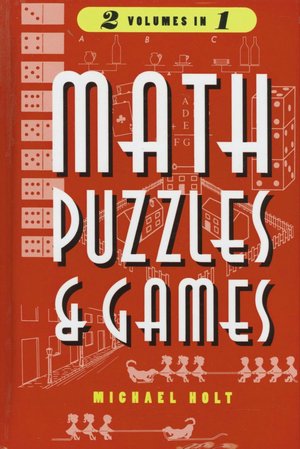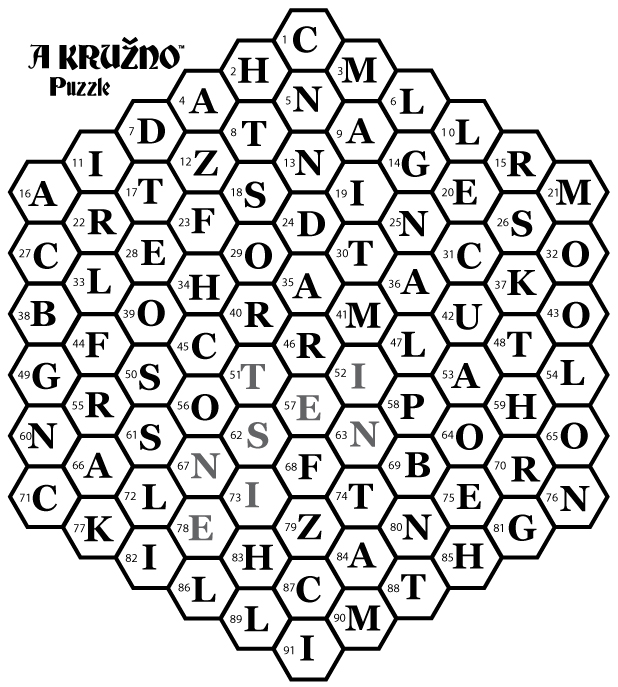A blog of tips and recommendations for anyone interested in learning or teaching mathematics.
Sunday, February 24, 2013
Bookshelf -- Math Puzzles & Games by Michael Holt
This is a nice little book. A good collection of puzzles concluding with an excellent set of games such as nine men's morris and tactix. It's also another example of the cheap but deserving books Barnes and Noble used to find and republish. They've shut down that division but it's still worth seeking the imprints out when you're in a used book store.
More Alexandria Word Searches
In a previous post, I mentioned a hexagonal variation on the old-fashioned word search. If you enjoyed those, here are a few more for you.
Thursday, February 21, 2013
O T T F F S S E...
Prompted partially partly by this highly recommended episode of This American Life, I've been thinking a lot recently about the soft skills of learning. In this case alertness.
One of the reasons I'm such of advocate of games and puzzles in the classroom is the fact that they help cultivate a state of alertness. If you can get students in the habit of looking for patterns in a math puzzle, they'll probably keeps looking for patterns and underlying structures when they open their math books.
O T T F F S S E... is one of my favorites. The question is what's the next letter in the sequence It can completely stump a Ph.D. in mathematics but if you approach it right the answer should hit you immediately.
One of the reasons I'm such of advocate of games and puzzles in the classroom is the fact that they help cultivate a state of alertness. If you can get students in the habit of looking for patterns in a math puzzle, they'll probably keeps looking for patterns and underlying structures when they open their math books.
O T T F F S S E... is one of my favorites. The question is what's the next letter in the sequence It can completely stump a Ph.D. in mathematics but if you approach it right the answer should hit you immediately.
Sunday, February 17, 2013
Sunday, February 10, 2013
Sunday, February 3, 2013
Dismembered Puppy Math
There's a class of simple math problem that most fourth graders will get right and most tenth graders will get wrong. You can come up with any number of examples but I've found this one makes the most lasting impact:
You have four kids and thirteen puppies. How many puppies does each kid get?
The fourth grader will correctly answer "three with one left over." More often than not the tenth grader will answer "three point two five." At this point, I would remind the student that no one should ever get a fourth of a puppy and therefore this is one of those times when it makes more sense to talk about division with remainders.
Asimov (and, I'm sure, many others) observed that mathematical progress often came down to finding ways to allow people to solve more problems with less thought. Mathematicians like Leibniz and Gauss come up with elegant notation that allow us to do much of our work mechanically. Ideally this frees us up to think about more important questions, but sometimes it lets students get good marks and high test scores in math without thinking at all.
Eventually the habit of answering math questions without thinking about them will lead to problems (it's difficult to mindlessly shamble through real analysis), but for K through 12 it can actually be an advantage not to spend to much time asking questions and dwelling on implications. This is particularly true for standardized tests which tend to be time-constrained and focus on problems that can be solved mechanically.
Of course, I'm not suggesting that movement reformers are in favor of the dismemberment of cute little puppies, kittens or any other loveable pets, but, as in other cases, I wonder if they've really thought this through.
Originally posted in Education and Statistics
You have four kids and thirteen puppies. How many puppies does each kid get?
The fourth grader will correctly answer "three with one left over." More often than not the tenth grader will answer "three point two five." At this point, I would remind the student that no one should ever get a fourth of a puppy and therefore this is one of those times when it makes more sense to talk about division with remainders.
Asimov (and, I'm sure, many others) observed that mathematical progress often came down to finding ways to allow people to solve more problems with less thought. Mathematicians like Leibniz and Gauss come up with elegant notation that allow us to do much of our work mechanically. Ideally this frees us up to think about more important questions, but sometimes it lets students get good marks and high test scores in math without thinking at all.
Eventually the habit of answering math questions without thinking about them will lead to problems (it's difficult to mindlessly shamble through real analysis), but for K through 12 it can actually be an advantage not to spend to much time asking questions and dwelling on implications. This is particularly true for standardized tests which tend to be time-constrained and focus on problems that can be solved mechanically.
Of course, I'm not suggesting that movement reformers are in favor of the dismemberment of cute little puppies, kittens or any other loveable pets, but, as in other cases, I wonder if they've really thought this through.
Originally posted in Education and Statistics
Subscribe to:
Posts (Atom)






